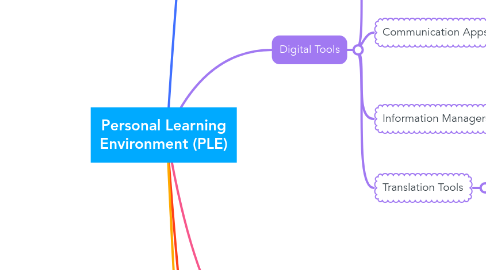
1. Learning Strategies
1.1. Listening
1.1.1. Podcasts in English
1.1.2. Audiobooks
1.1.3. Songs and lyrics
1.2. Speaking
1.2.1. Language exchange
1.2.2. Conversation groups
1.2.3. Oral practice apps
1.2.3.1. HelloTalk
1.3. Reading
1.3.1. News articles in English
1.3.2. Books and novels
1.3.3. Blogs and forums in English
1.4. Writing
1.4.1. Diary in English
1.4.2. Personal blogs
1.4.3. Emails and correspondence
1.5. Grammar
1.5.1. Tenses
1.5.2. Conditionals
1.5.3. Modals
1.5.4. Reported Speech
1.5.5. Articles
1.5.6. Prepositions
1.5.7. Expressing Commonalities
2. Digital Tools
2.1. Learning Platforms
2.1.1. Duolingo
2.1.2. Babbel
2.1.3. Rosetta Stone
2.2. Communication Apps
2.2.1. WhatsApp
2.2.2. Skype
2.2.3. Zoom
2.3. Information Managers
2.3.1. Evernote
2.3.2. Google Keep
2.4. Translation Tools
2.4.1. Google Translate
2.4.2. DeepL
3. Resources and Materials
3.1. Open Educational Resources
3.1.1. MOOCs
3.1.1.1. Coursera
3.1.1.2. edX
3.1.2. YouTube
3.1.2.1. educational channels
3.1.3. Webinars and online workshops
3.2. Reference Materials
3.2.1. Online dictionaries
3.2.2. Grammar manuals
3.2.3. Style guides
4. Application in the Workplace
4.1. Written Communication
4.1.1. Writing emails
4.1.2. Reports and presentations
4.1.3. Technical documentation
4.1.4. Notion
4.2. Oral Communication
4.2.1. Meetings and conferences
4.2.2. Oral presentations
4.2.3. Negotiations and calls
4.3. Training and Development
4.3.1. In-company English courses
4.3.2. Mentorship programs
4.3.3. Seminars and workshops
5. Support and Collaboration Network
5.1. Online Communities
5.1.1. Facebook groups
5.1.2. Learning forums
5.1.3. Language exchange platforms
5.2. Professional Network
5.2.1. LinkedIn
5.2.2. Professional associations and networks
5.2.3. Networking
